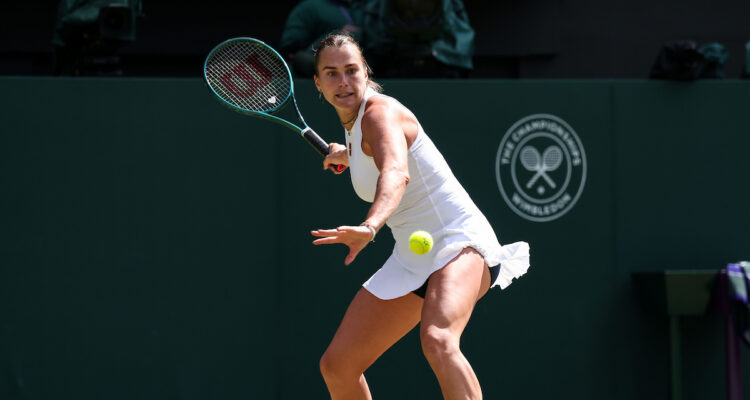WIMBLEDON/WASHINGTON, July 8, 2025 (by Michael Dickens)
A day after going from triumph to disaster within a matter of a few seconds, from watching Grigor Dimitrov put on a remarkable performance in going up two-sets-to-none over top seed Jannik Sinner before seeing him retire in tears, Day 9 of the Wimbledon Championships on Tuesday continued to live up to our expectations, while tugging at our emotions.
With the quarterfinal round underway on both Centre Court and No. 1 Court at the All England Club, the lowest-ranked woman in the last eight – and the oldest player in the Open Era to reach her first Wimbledon Ladies’ singles quarterfinal, Laura Siegemund, came ready to play. She looked rock solid for much of her nearly three-hour last-eight match against top seed Aryna Sabalenka.
The Centre Court audience, filled to the last row, acknowledged both players with plenty of cheer and applause. Could Siegemund provide fans with an upset of the No. 1 player in the world that Dimitrov was on the verge of before he injured himself and had to retire the day before? Maybe. As it turned out, it would require 198 points to decide the exciting outcome.
By the end, though, Sabalenka showed why she’s No. 1 after surviving a three-set, 4-6, 6-2, 6-4 scare from Siegemund that lasted two hours and 54 minutes. It was the longest women’s match during the British fortnight. After securing match point, Sabalenka had solved the puzzle that was Siegemund that no one else had been able to figure out.
Comeback complete
World No.1 Aryna Sabalenka defeats Laura Siegemund 4-6, 6-2, 6-4 to reach her third #Wimbledon semi-final. pic.twitter.com/VBfLu53Evz
— Wimbledon (@Wimbledon) July 8, 2025
Sabalenka finished the victory by hitting 29 winners to 36 unforced errors, won 25 of 43 net-point exchanges, converted eight of 13 break points and outpointed Siegemund 104-94. Siegemund countered with 28 winners, made 35 unforced errors and broke Sabalenka’s serve six times in 11 tries.
Although Sabalenka may not have been at her best – all credit to Siegemund for that – she won 12 of the last 16 games to pull out the last eight victory. The win advanced Sabalenka to her 12th career major semifinal – her fourth straight going back to last year’s US Open – and third at Wimbledon. It was her 11th major victory after dropping the opening set since 2022.
During her on-court interview, a happy but relieved Sabalenka said: “I need some time to cool down and recover. [Laura] pushed me so much. After the first set I was looking at my box like ‘Guys, book the tickets. We’re about to leave this beautiful city.’”
The 37-year-old German broke the World No. 1 Sabalenka twice – with an attack of slice and dice and deceptive drop-shot tennis – and built up a 3-0 lead in the opening set before the World No. 1 from Belarus knew what hit her. She would break Sabalenka in three of the first four service games to build up a 5-2 lead. Although Sabalenka won eight of the next 11 points and broke serve to trial 5-4, Siegemund finished what she started – winning all the important rallies. She fought hard – won the battle of minds – and captured the 57-minute first set 6-4 as Sabalenka’s frustrations got the best of her. It was the first set Sabalenka had lost all tournament.
Siegemund’s shining on Centre
The German takes the first set against world No.1 Aryna Sabalenka 6-4#Wimbledon pic.twitter.com/ToOP4twApD
— Wimbledon (@Wimbledon) July 8, 2025
As the second set unfolded, Siegemund broke Sabalenka for the fourth time to get back on serve at 2-all. However, the Belarusian rallied from down love-40 and broke for a 4-2 advantage. Sabalenka saved a break point during a battle-royale of a seventh game for 5-2, and pulled through a 12-point, 10-minute-plus eighth game to break Siegemund to win the 54-minute second set 6-2. It was on to a decider.
Siegemund broke Sabalenka to go ahead 2-1 after winning a thrilling 12-shot rally by playing cat-and-mouse tennis. She consolidated the break on her serve despite receiving a time warning. However, Sabalenka broke back to level the decider at 3-all. Then, with all the tension and drama at its most, Siegemund broke to go ahead 4-3 after Sabalenka’s backhand deserted her. It was the sixth time Sabalenka’s serve had been broken – equaling the number of times her serve was broken through her first four matches. But Sabalenka fought back and broke to win a 10-point game and level the final set at 4-all.
A roar of relief ️#Wimbledon pic.twitter.com/nMX5hRVpcK
— Wimbledon (@Wimbledon) July 8, 2025
Next, Sabalenka served her first two aces of the match to hold for 5-4, and it was up to Siegemund to hold on in order to prolong the quarterfinal match. Sabalenka gained a match point at 15-40 after Siegemund hit a forehand return beyond the baseline. But the German saved it with a backhand drop shot winner from mid court. Finally, Sabalenka won the quarterfinal tussle on her second match point try with a sixth-shot overhead winner. Soon, she and Siegemund shared a hug at the net. All was good between them.
As Sabalenka blew kisses to the crowd, which included actors Sir Ian McKellen and Jodie Foster sitting in the front row of the Royal Box, she showed a look of relief. At last, the three-time major champion had finally crossed the finish line. Afterward, she praised Siegemund’s style of play during her on-court interview. “It’s not like it’s an annoying game. It’s a smart game,” Sabalenka said. “She’s really making everyone work against her.
“Going into the match against her you know you have to work for every point. Doesn’t matter if you’re a big server or hitter. You have to work. You have to run.
“I was trying to focus on myself and make sure I don’t give her that energy. I didn’t want her to see that I was annoyed by her. Even if I was a little bit at some points.”
“The atmosphere is another level”
Aryna Sabalenka thanks the crowd for supporting her through a tough match against Laura Siegemund. #Wimbledon pic.twitter.com/9FJH8Ky6TU
— Wimbledon (@Wimbledon) July 8, 2025
Coming in with 12 career wins against Top-10 opponents – but now 0-5 against No. 1-ranked players following Tuesday’s loss – Siegemund was hungry to prove her critics wrong that she didn’t belong. Even in defeat, Siegemund very much belonged – and showed why she was the surprise of this year’s women’s draw.
En route to the quarterfinals, Siegemund put together a clean slate of four wins without dropping a set. She defeated No. 36 Peyton Stearns of the United States, No. 29 seed Leylah Fernandez of Canada, upset No. 6 seed Madison Keys of the United States and looked solid in beating 100th-ranked lucky loser Solana Sierra of Argentina, dropping just 22 games total. She fought for every game.
“I have this game and maybe this boldness – I don’t know if that’s the right word in English – to take out big names,” Siegemund said during one of her recent post-match news conferences. “I’ve always had that, just maybe because I don’t care who’s on the other side – and in a positive and respectful way I don’t care. I’m just focusing on me and on my job. That’s it. I don’t play against a name, I play against someone who plays in a certain style.”
A fitting applause for Laura Siegemund who played her part in an enthralling Centre Court encounter
Congratulations on a brilliant run at The Championships pic.twitter.com/6wmbPP0Hd5
— Wimbledon (@Wimbledon) July 8, 2025
That’s confidence, and Siegemund began her quarterfinal match against Sabalenka with plenty of it. In her sixth Wimbledon appearance, after never advancing past the second round, Siegemund equaled her best major result in her 29th Grand Slam main draw – the same number of Grand Slam main draws as Sabalenka, 10 years her junior.
However, by the end, while Siegemund lived for the fight and received a standing ovation as she left Centre Court, Sabalenka proved her mettle in the toughest moments – found a way to prevail – and the reward is she gets to live to play another day.
The moment Sabalenka sealed her SF spot #Wimbledon pic.twitter.com/tUA6AUwtY8
— Wimbledon (@Wimbledon) July 8, 2025
Next up, in Thursday’s semifinal round, Sabalenka will face No. 13 seed Amanda Anisimova of the United States, who became a first-time Wimbledon semifinalist after defeating No. 50 Anastasia Pavlyuchenkova of Russia, 6-1, 7-6 (9), in one hour and 39 minutes on No. 1 Court. The second set lasted 73 minutes alone and saw Anisimova squander a 5-2 lead. She finally wrapped up the quarterfinal victory on her fourth match-point opportunity.
Anisimova hit 26 winners and overcame 27 unforced errors. She outpointed Pavlyuchenkova 84-67. The victory improved Anisimova’s Wimbledon win-loss record to 10-3.
The smile on her face!
Amanda Anisimova takes down Anastasia Pavlyuchenkova 6-1, 7-6(9) to reach her first #Wimbledon semi-final pic.twitter.com/8QMwLHtGap
— Wimbledon (@Wimbledon) July 8, 2025
It will be Anisimova’s first major semifinal since she reached the last four at the 2019 French Open as a 17-year-old phenom, who stunned Sabalenka and Simona Halep before succumbing to eventual champion Ashleigh Barty in the semis. Now 23, she’s playing some of the best tennis in her life and is set to break into the WTA Top 10 next week.
“I mean, its been an extraordinary year for me. So many highs. It’s just been such a ride, and I’ve been enjoying every step of the way,” Anisimova said during her on-court interview, accompanied by her soon-to-be four-year-old nephew Jackson. “Even times like today, when you’re not sure you’re going to cross the finish line, I keep reminding myself to enjoy the moment.”
“It’s not often you get to play on this special court”
What a year it’s been for Amanda #Wimbledon pic.twitter.com/BDyaTRkwFu
— Wimbledon (@Wimbledon) July 8, 2025
Fritz advances to second major semifinal, Alcaraz next
No. 5 seed Taylor Fritz of the United States needed four sets to put away No. 17 seed Karen Khachanov of Russia, 6-3, 6-4, 1-6, 7-6 (4), in two hours and 36 minutes on No. 1 Court – a short length in sets and time by Fritz’s standard after enduring a couple of earlier five-set thrillers. However, the victory advanced the American No. 1 to his second major semifinal – and first at Wimbledon – and he’s the first active U.S. man to reach the semifinal of a non-hard court major.
Fritz garnered his 13th win on grass this season – which leads the ATP Tour – after overcoming a mid-match lapse against Khachanov, in which he lost five straight games to start the third set. By the end, he earned his first win over the Russian No. 2 in three career meetings. Three years after he fell in a five-set heartbreaking quarterfinal defeat to Rafael Nadal, Fritz maintained his nerve.
Taylor’s Triumphant
Fritz wins in four and awaits the winner of Alcaraz and Norrie in the SF #Wimbledon pic.twitter.com/W1Sunqie0E
— Wimbledon (@Wimbledon) July 8, 2025
Fritz took a medical time out to receive treatment on his right foot after losing the third set, then promptly was broken by Khachanov. However, Fritz, who earlier this grass-court season won titles at Stuttgart and Eastbourne, battled back and leveled the deciding set at 2-all. He played solidly, both down the stretch and during the tie-break.
“I’m feeling great to get through it,” Fritz said during his on-court interview. “I feel like the match was going so well for me for two sets. I’ve never had a match really just flip so quickly, so I’m really happy with how I can back in the fourth set and got it done. I think the momentum was definitely not going to have been on my side going into a fifth.”
“I’m really happy with how I’ve turned my career around.”
After losing in the #Wimbledon QF twice, Taylor Fritz is now in his first semi-final at SW19 pic.twitter.com/x5OZbeNrGu
— Wimbledon (@Wimbledon) July 8, 2025
Fritz finished the quarterfinal with 47 winners – including 16 aces – and won 17 of 24 points at the net. He converted three of eight break points and outpointed Khachanov 119-105. Although Khachanov struck 35 winners, he also commmitted 38 unforced errors.
“It’s an amazing feeling,” Fritz said after earning his first Wimbledon quarterfinal victory. “Obviously having played the quarterfinals here twice and lost in five [sets] twice, I don’t think I could have taken another one. So I’m really happy I’m going to get to play the semis here.”
Now, Fritz will get to enjoy two days off before returning to play two-time defending champion Carlos Alcaraz of Spain in the semifinals, against whom he is 0-2. The No. 2 seed from Spain defeated British No. 1 Cameron Norrie, ranked 61st, 6-2, 6-3, 6-3, in one hour and 39 minutes on Centre Court for his 23rd straight victory, which has included winning titles at Rome, Roland-Garros and Queen’s Club. It was also Alcaraz’s 19th straight tour-level triumph. His last loss came in April against Holger Rune in the Barcelona final.
19 wins in a row at #Wimbledon
Carlos Alcaraz defeats Cameron Norrie 6-2, 6-3, 6-3 to reach the semi-finals for the third consecutive year. pic.twitter.com/FFzXV6T6Nb
— Wimbledon (@Wimbledon) July 8, 2025
Alcaraz controlled his quarterfinal match against Norrie from first ball to last ball. He struck 39 winners – including 13 aces – won 89 percent of his first-serve points and saved all five break points he faced. Alcaraz broke his opponent five times in 11 opportunities, won 22 of 31 net-point exchanges and outpointed Norrie 94-65. Norrie was appearing in his second Wimbledon quarterfinal.
“I’m just really happy to be able to play another semifinal here at Wimbledon,” Alcaraz said during his on-court interview. “It’s something really special and something that I wanted to do at the beginning of the week. I’m really happy with the level that I played today against a difficult player like Cam. I’m pretty sure that there is nobody working harder than him, so I’m happy to see him playing these kinds of matches.”
The victory improved Alcaraz’s lifetime record at the All England Club to 23-2. He’s through to his eighth career major semifinal since – and third at Wimbledon. Alcaraz is only the second active man to advance to three or more Wimbledon semifinals, joint seven-time Wimbledon champion Novak Djokovic.
The quest for a third consecutive #Wimbledon title continues pic.twitter.com/PHHEe6i8hJ
— Wimbledon (@Wimbledon) July 8, 2025
Around the All England Club
Wednesday on Centre Court, seven-time champion Novak Djokovic, seeded sixth, will face Italian upstart Flavio Cobolli, who is the No. 22 seed, for a berth in the Wimbledon semifinals. A win for Djokovic will give him another Wimbledon record to savor. After equalling Roger Federer‘s mark of 13 Wimbledon semifinals last year, Djokovic would claim sole possession of the all-time record for most appearances in the men’s singles semifinals with 14. He will also be aiming to reach a record-extending 52nd Grand Slam semifinal.
Father Time?@DjokerNole hasn’t heard of it.#Wimbledon pic.twitter.com/IdtmAFF1UB
— Wimbledon (@Wimbledon) July 7, 2025
Wednesday’s Wimbledon order of play
By the numbers
• On Tuesday, Aryna Sabalenka appeared in her 11th consecutive Grand Slam quarterfinal. The last time she failed to reach the stage of the last eight at a major was in 2022 at Roland-Garros, where she lost to Camila Giorgi in the third round. The last player to reach as many consecutive quarterfinals since 2000 was Serena Williams, who made 16 straight between Wimbledon 2000 and the Australian Open in 2005.
• Taylor Fritz is the 15th active player to reach the men’s singles semifinals at Wimbledon. He’s also the third active American male player to reach multiple Grand Slam semifinals, after Frances Tiafoe and Ben Shelton.
“Quotable …”
“We did go out to the indoor courts and just fed balls [to him] for 20-30 minutes, just to feel the ball. He’s going to be okay, it was just nice to get on the court. it’s impossible for him to take a day off.”
– Darren Cahill, Jannik Sinner’s coach, appearing on ESPN Tuesday evening. Cahill was responding to Sinner’s condition after the World No. 1 fell during the first set of his fourth-round match against Grigor Dimitrov Monday evening and appeared to have injured his right wrist and right elbow.







